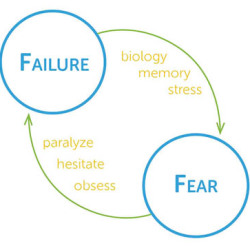Failure and fear are close relations. To put it broadly, we fail when our expectations don’t match an outcome. We remember this often negative experience and can become fearful when we perceive a chance of failure in the future. When we’re fearful we’re less likely to perform at our best, making us more likely to fail.
Our biology also contributes to feelings of fear. The Amygdala , part of our brain stem, is a primitive component of our brain responsible for communicating basic needs. It sends two types of failure-focused alerts: “we are in need of something” and “we are under attack”. We experience this as a “fight or flight” response, and it can be pretty emotional.
When our amygdala is stimulated, the survival-focus of its message overwhelms less essential thoughts, so our brain is constantly working to rationalize ancient anxieties triggered in our modern life. Consider your mood when you’re hungry; the basic need to eat overwhelms our ability to focus on anything else. It doesn’t matter that we’re rarely in danger of never finding food – the Amygdala stresses us out as if we are!
Because fear and failure are so closely related, alleviating one can help break the cycle. Reducing fear can help us move forward and avoid thoughts that can contribute to self-sabotage, and shifting personal views on failure can help us be more accepting when things don’t go right.
But where to start?
The short answer is: just start somewhere. Trying to block out fear or failure often causes more stress – because essentially we’re trying to outsmart our own (incredibly complex) brain. There is no fool-proof strategy to manage this cycle, but understanding it, taking a look at our own tendencies and changing some behaviors is a step in the right direction.
If you think about it, we fail quite frequently – we just don’t consider every mishap a failure. For example, missing a deadline can be a greater detriment to a project than, say, accidentally sending an email before you’ve proofread. We consider the email a mistake, but not a failure, and it has less of a long-term effect on us than missing a deadline would.
What we can learn?
Though it may seem inconvenient to take on fear and failure as partners, there are practical purposes to this uncomfortable relationship. First, it’s hard for us to learn from success. Without friction, no practices can emerge as better or worse so it can be difficult to tell why we’re successful. It’s great to succeed, but it’s harder to replicate if we don’t know why it happened.
Failing together also builds community. If individuals fail constructively, teams can co-evolve through failure – moving closer to their goals, and learning how to work with each other in the process. Taking responsibility helps new skills emerge, strengthens relationships and helps build respect among team members.
Approaching fear and failure as inevitabilities can help us manage the root of frustration, improving how we approach our work instead of encouraging us to bury the symptoms (“get over it!”). When we have a more accurate view of what’s natural and unavoidable we can focus energy on the things ew can control, get out of our own way and make our projects run more smoothly.
This post was first published at workingexamples.org.
